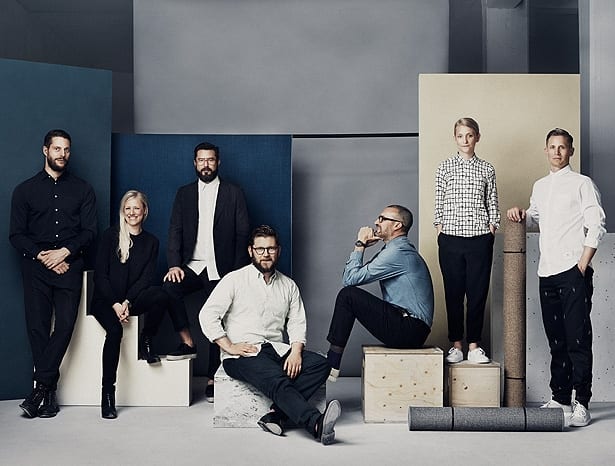 Cristiano Pigazzini (third from right) with his Note comrades||
Cristiano Pigazzini (third from right) with his Note comrades||
The boundaries between contract and home furniture have grown increasingly fuzzy lately, but Cristiano Pigazzini, co-founder of Swedish design studio (and former onoffice cover stars) Note, believes that the division is now disappearing entirely.
Speaking ahead of February’s Stockholm Furniture Fair, where Note will launch a host of new pieces for various brands, Pigazzini says he has noticed a widespread convergence in the approach to furniture design, production and marketing. “The products once looked different from each other,” he says. “Contract wasn’t so fun – the products looked indestructible. With home products, you could play a bit more. But the differences aren’t so clear any more.”
The shift has stemmed from how we work and live differently, he says. Whereas workers once sat at a desk from nine to five, now it doesn’t matter when or where you work, it just matters what you do, so work is done in a variety of environments. This has created the need for an office that looks like home.
“For companies like Google, Skype and Facebook, their office is like a playground, with furniture that ten years ago would be impossible to use in this type of space,” says Pigazzini. This has put pressure on furniture manufacturers to make their entire range contract-proof. “Companies are talking about quality and longevity, but no one is saying ‘this will only work for home’ because then people will ask ‘why, because it’s worse quality?’” he continues. Freedom has been handed back to the customer, in that sense, because “instead, companies just make good furniture, and it doesn’t matter how you use it.”

Swedish brand Fogia, for which Note designs (Sling chair pictured above) and works on creative strategy, has removed the home and contract sections from its website for this very reason. Pigazzini points out that the top Danish brands like Muuto, &tradition, Normann Copenhagen and Hay are all thinking in a similar way.
This doesn’t mean office furniture brands are irrelevant, but that they need to rethink their approach. In fact it’s opened up the market, with leading companies taking advantage of new opportunities. “Now, we might need a classic office chair at home for a small office, and a huge sofa in the office for long meeting. Technology has given us that flexibility,” says Pigazzini. Many specifiers are still stuck in the old ways, but most are waking up to the new mindset. “I think they’re realising the process doesn’t start with what type of furniture they need; it’s about how they work, then you go from there. When you hear that kind of question you realise things are changing.”
Of course there are large portions of the industry that haven’t caught up just yet. “If you go to Milan Furniture Fair and take a look at the office area, it feels like it’s 1990. Come on, wake up!” he laughs. “Then you go back to where all the other brands are and think, OK, this is my office.”
At the Stockholm fair, Note will be launching new products for Fogia and Danish brand Menu; a light for Swedish company Zero; an armchair for Won (also Danish); and a portable desktop divider called Focus for Swedish acoustic brand ZilenZio (below). This fold-up acoustic screen is small enough to fit in your bag, says Pigazzini, and designed to help mobile workers in cafes and libraries create “their own private space in a public place”. It’s a pertinent example of the way we can now work anywhere, and how this has opened up new markets for a different type of design for the workplace.

Now that contract and home furniture is aesthetically similar, let’s make everything contract-proof, says Note Design Studio’s Cristiano Pigazzini






















